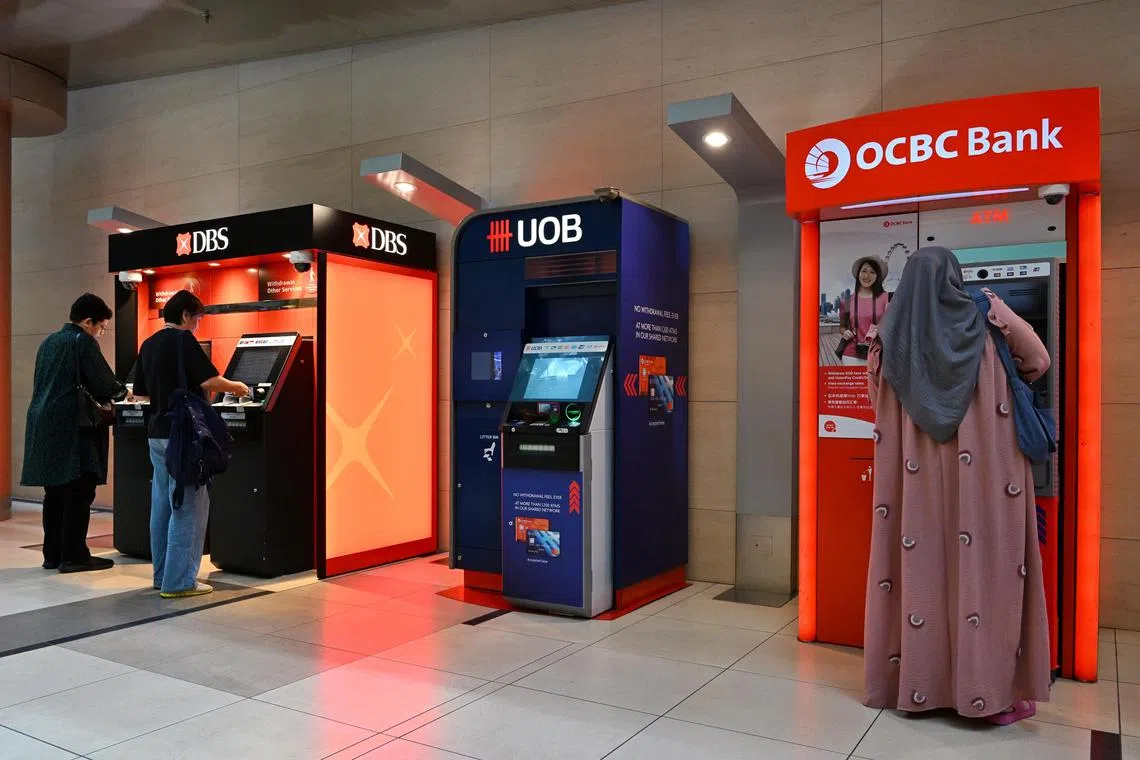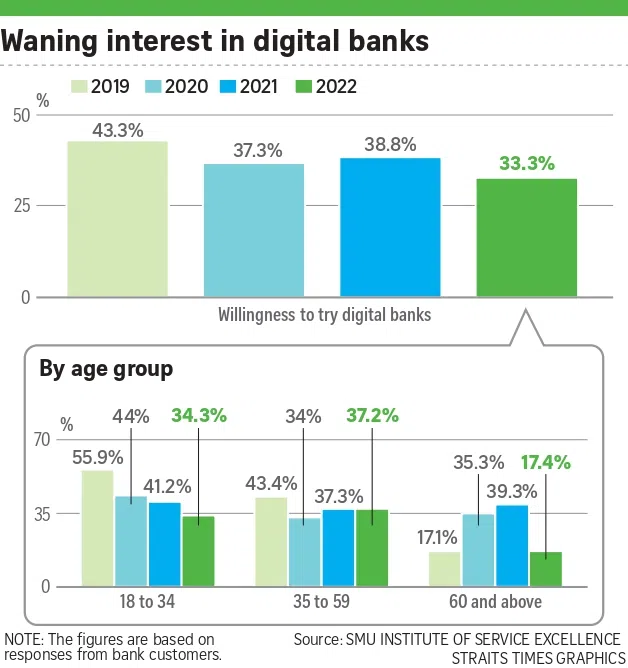Customers more satisfied with finance sector, less willing to use new digital banks: SMU study
Sign up now: Get ST's newsletters delivered to your inbox

Among banks, DBS led in customer satisfaction with 75.9 points. It was trailed by Citibank with 75.1 points, and OCBC and UOB, which both scored 75 points.
ST PHOTO: CHONG JUN LIANG
Follow topic:
SINGAPORE – Customer satisfaction with the finance sector in the Republic has increased amid steps by banks to boost their online banking security, while there is less interest in newcomer digital banks.
These findings were part of a national study on customer satisfaction released on Tuesday that Singapore Management University’s Institute of Service Excellence (ISE) conducts quarterly and annually.
The Customer Satisfaction Index of Singapore measures satisfaction across six key sectors in the service industry, including tourism, retail, land transport, and food and beverage.
The finance sector’s score improved by 0.9 per cent year on year in the fourth quarter of 2022, rising to 75.5 points out of a possible 100.
A total of 4,700 local consumers were surveyed between October 2022 and January regarding the finance and insurance sectors.
Within the finance sector, the banks sub-sector scored 75.6 points, up 1 per cent year on year, while the credit cards sub-sector scored 73.8 points, a 0.9 per cent increase.
But e-payment apps fell by 1.8 per cent, scoring 75.6 points.
Among the banks, DBS led in customer satisfaction with 75.9 points. It was trailed by Citibank with 75.1 points, and OCBC and UOB, which both scored 75 points.
The survey found that customer perceptions of quality were driven by considerations of whether banks had their best interests at heart, and whether products and services were available when they wanted them.
ISE executive director Neeta Lachmandas said on Tuesday that steps recently taken by financial institutions to boost digital banking security have resulted in positive sentiment among customers.
For example, Singapore banks in 2022 removed clickable links in SMSes and rolled out an emergency self-service “kill switch”
These were part of industrywide measures introduced after a spate of SMS phishing scams targeting bank customers.
But banks will need to continue to show that they put their customers’ best interests at heart amid issues such as digital disruptions, said Ms Lachmandas.
DBS in March set up a special board committee to investigate
Ms Lachmandas said these incidents are part and parcel of the shift towards digital banking.
“As long as the banks respond in a very serious way, and they communicate well with their customers, and customers feel that their best interests are being put in the centre, then we should expect to see that the banks will continue to do well,” she told The Straits Times.
ISE’s study also found that physical banking services are still important to customers, even as 75.5 per cent of them recently used digital channels.
On average, each customer recently interacted with three unique bank touchpoints, including ATMs, bank branches and mobile apps.
Customers aged 18 to 34 accessed these touchpoints to a similar degree as older customers.
A higher proportion of younger customers – 12.2 per cent in 2022 compared with 7.4 per cent in 2021 – also consulted personal bankers and relationship managers.

Meanwhile, satisfaction in e-payment apps – including those offered by incumbent banks and non-banking e-wallets such as GrabPay and FavePay – dipped year on year across all age groups.
Those aged 18 to 34 were least happy with these apps, with a satisfaction score of 74.2 points.
They had poorer perceptions of the apps’ branding and user experience, and about the variety of merchants that accept the app.
Customers were also, on the whole, less willing to try digital banks.
GXS Bank and Trust Bank, which cater to retail customers and operate entirely online, made their debut in 2022. Interest in digital banks has faded, especially among customers aged 18 to 34 and those 60 and above.
But Ms Lachmandas cautioned that it is too early to make conclusions about the nascent digital banking ecosystem.
“News reports have indicated that the digital banks were not a game changer. That could be one of the reasons (for the decline in willingness to try these banks),” she said.
“Our traditional banks also have pretty strong digital products... I think the next few years will start to cement the role that the different parts of the banking ecosystem will play,” she said, noting that customers have expressed greater interest in using digital banks’ current and savings accounts.
Meanwhile, the insurance sector’s customer satisfaction score rose by 1.7 per cent year on year to 74.8 points.
It was mainly driven by its life insurance segment, where policyholders’ perceptions improved in areas such as insurers’ responsiveness and reliability.
Great Eastern led in customer satisfaction with 76 points, followed by AIA with 75.5 points and Income with 75 points.
The finance and insurance sectors helped to push overall customer satisfaction for the service industry to 74.6 points in 2022, up by 1.1 per cent from 2021. This was the highest customer satisfaction level the study has recorded since its inception in 2007.


